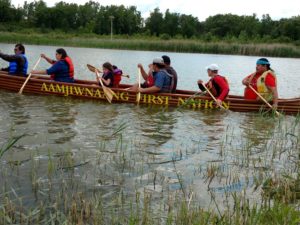Recently launched canoe to reconnect youth with heritage

By Colin Graf
AAMJIWNAANG FIRST NATION—The recent launch of a new cedar-strip canoe in Aamjiwnaang First Nation marks an important step in a program to reconnect Indigenous youth with their heritage and promote a new approach to fitness across First Nations in Ontario.
The community canoe, named Niigannii (leader), met water for the first time last on July 1, along with its future racing competitor from Chippewa of the Thames First Nation (COTTFN).
The launch of the 26 foot craft marks the second major step in the program, Ogitchidawe Niibi, the Water Warriors, run by the Aboriginal Sport & Wellness Council of Ontario.
“The goal of the program is to get Indigenous youth healthy, active, and on the water,” stated Keir Johnston, project assistant with ASWCO.
Johnston, a national and international competitor in canoe and kayak, hopes to continue promoting canoe-building and paddling across the province until enough First Nations have canoes with capable crews to hold a racing competition or regatta.
“With so many First Nations people living near waterways, re-connecting them with the water, the source of life, and their heritage in paddling is a natural idea to promote physical activity,” says Johnston’s sister Carlyn, a former competitor in the North American Indigenous Games, along with her brother. “The waterways were our highways.”
According to Keir, the canoe, a labour of love by a dedicated Aamjiwnaang crew, was built with about 6 hours of work per week from September 2016 until last May.
Construction was supervised by Rene Boogemans, a paddler from Hensall, Ontario, who has built canoes for many years.
Boogemans noted that both Aamjiwnaang and COTTFN canoes were built from moulds used to construct similar canoes that completed a famous race in 1967, from Cumberland House in Manitoba to Montreal.
Now that the canoes are finished and are water-tested, the Johnston siblings are concentrating on developing paddling teams at the two southwestern Ontario communities. Interest is growing a little faster in Chippewas of the Thames, with some 25 people participating in canoe night each Monday on the Thames River.
“COTTFN has eight recreational canoes, along with several kayaks, and access to six racing canoes from Team Ontario,” says Carlyn.
Paddlers have even built a traditional birch-bark canoe there recently.
The Johnstons hope to get a 6-paddler crew ready for competition from each community when other First Nations get their own canoes built.
The Aamjiwnaang canoe will be on display when competitors gather in July for the 2017 Games in Toronto.
Credit for creating the program belongs to their mother, Sharilyn Johnston of Aamjiwnaang, a paddler herself.
Johnston, environmental coordinator of Aamjiwnaang, says she has great hopes for the new program.
“The canoe-building component teaches skills in cooperation, commitment, and pride in completion of a project,” she says. “While the cultural component emphasizes the importance of the canoe in First Nations history, and reminds participants of the ceremonies involved in asking for the materials and in the naming of the canoe.”


